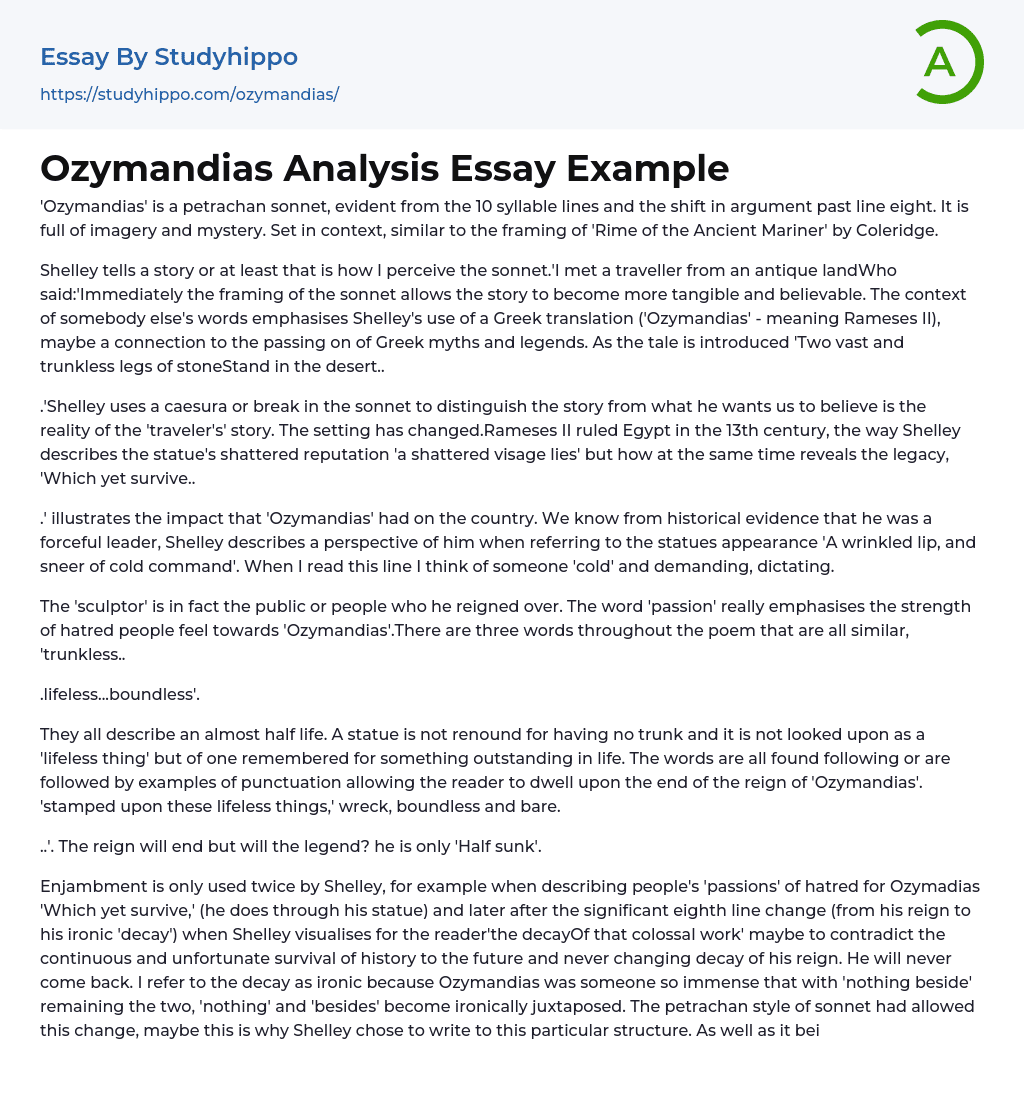The poem 'Ozymandias' is a Petrarchan sonnet, as can be determined from its 10-syllable lines and the change in the argument after line 8. It contains rich imagery and an element of enigma, much like the structure of 'Rime of the Ancient Mariner' by Coleridge.
The sonnet by Shelley appears to tell a story, as conveyed through the framing of the text. In the sonnet, a traveler from an ancient land recounts a tale, specifically using a Greek translation for the name "Ozymandias," which means Rameses II. This connection to Greek mythological tales is emphasized by the use of another person's storytelling to introduce the narrative. The story begins with the description of "two vast and trunkless legs of stone" standing in the desert.
Shelley employs a caesura in the sonnet to differentiate the story from the perceived actuality of the "traveler's" tale. The location has shifte
...d to Egypt under the reign of Rameses II in the 13th century. Shelley portrayed the statue's desolate state with "a shattered visage lies" yet simultaneously acknowledges its endurance with "Which yet survive...".
'Ozymandias' had a significant impact on the country. Historical evidence confirms that he was a powerful leader. Shelley's depiction of the statue's appearance, 'A wrinkled lip, and sneer of cold command', suggests a cold and dictatorial demeanor.
Within the poem, the 'sculptor' represents the public or those whom 'Ozymandias' ruled over. The use of the term 'passion' highlights the intense animosity harbored towards 'Ozymandias'. The consistent appearance of three similar words- 'trunkless..' throughout the poem serves to further emphasize this sentiment.
Lifeless and boundless.
The phrases in the text describe the length of a nearly half-life. Although a
statue may lack a trunk, it is not considered "lifeless," but rather remembered for something notable during its lifetime. These words are either preceded or followed by punctuation marks that encourage readers to reflect on the downfall of "Ozymandias." Examples include "stamped upon these lifeless things," "wreck," "boundless," and "bare."
Will the legend persist even after the end of the reign when he is only "Half sunk"?
Shelley only uses enjambment twice in his writing. One example is when he vividly describes people's hatred for Ozymadias and how it still persists, even after his statue remains. Later on, Shelley changes the eighth line for a better effect and then uses the enjambment style when describing the colossal work's decay. This is done to highlight the irony of how history can survive but Ozymandias's reign doesn't. It is worth noting that the Petrarchan style of sonnets allowed Shelley to make these changes. This is why he chose to write within this structure. The sonnet style is known to be straightforward and concise.
When it comes to emotional impact, highlighting individual words is more effective than using free verse with smooth sentences. Such highlighting is concise and demands the use of strict techniques like assonance or consonance. For instance, in Shelley's "Ozymandias," the repeated "s" sound in "sand...shattered...survive...stamped" creates a contradiction or juxtaposition of meaning, much like the contrast between Ozymandias' reign and his eventual decay.
- Book Summary essays
- Metaphor essays
- Reader essays
- Rhyme essays
- Literary devices essays
- Villain essays
- Books essays
- Genre essays
- Literary Criticism essays
- Writer essays
- Protagonist essays
- Simile essays
- Poem essays
- Book Report essays
- Book Review essays
- Greek Mythology essays
- Plot essays
- Tragic Hero essays
- Coming of Age essays
- Play essays
- Rhetoric essays
- Rhetorical Question essays
- Translation essays
- Understanding essays
- Reason essays
- Character essays
- Letter essays
- American Literature essays
- Literature Review essays
- Utopia essays
- Poetry Analysis essays
- Dante's Inferno essays
- Between The World and Me essays
- Incidents in The Life of a Slave Girl essays
- Flowers for Algernon essays
- Myth essays
- Everyday Use essays
- Boo Radley essays
- Genesis essays
- Richard iii essays
- Alice in Wonderland essays
- On the road essays
- Ozymandias essays
- The Nightingale essays
- Holden Caulfield essays
- Animal Farm essays
- 1984 essays
- A Hanging essays
- Shooting An Elephant essays
- A Tale Of Two Cities essays




